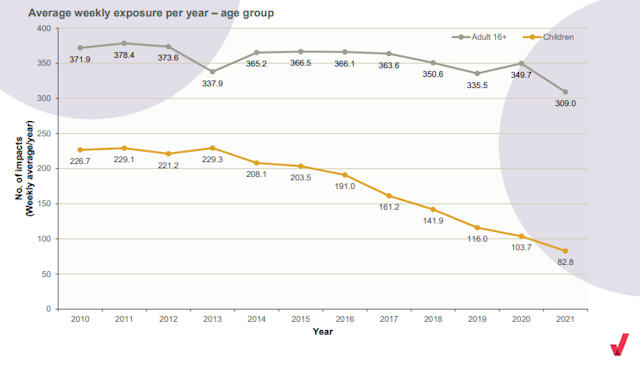Children’s exposure to inappropriate TV ads hits record low
According to new research, children’s exposure to inappropriate TV ads has hit a record low, but it remains an issue on other platforms.

Children's exposure to alcohol and gambling ads continues to fall / Kvnga
Children’s exposure to inappropriate advertising has been a concern for the marketing industry for decades. The issue has been exacerbated by the rapid rise of digital advertising, which remains opaque and open to abuse in many ways.
In more traditional media, however, there has been progress in safeguarding children from inappropriate ads. A report from the Advertising Standards Authority (ASA) has found that kids’ exposure to alcohol ads on TV since 2010 has decreased by three quarters. Children now see an average of 0.8 ads a week related to alcohol, down from 3.2 in 2010.
The report notes that alcohol ads now make up just 1% of all TV ads seen by children.
When it comes to gambling there has been slightly less progress. Over the same time period, children’s exposure to TV gambling ads decreased by just over a quarter, with the report stating: “The 2021 exposure levels of 2.2 gambling ads a week represents the lowest level in the 12-year period covered and is half that of the peak average of 4.4 gambling ads per week in 2013.”
However, progress has been made relative to the amount of gambling ads viewed by adults. Children’s exposure to gambling ads relative to adults’ has fallen year-on-year from 36% in 2010 to 15% in 2021, the lowest in the 12-year period. It means children saw, on average, just under one TV ad for gambling for every six seen by adults in 2021.

Those falls are partly due to the fact that the total amount of TV ads to which children are exposed has dramatically fallen. Between 2010 and 2021 the average ads watched by children decreased almost two thirds. As of the 2021 statistics, children see 82.8 ads a week, the lowest in the 12-year analysis period.
That is a direct result of the amount of time children spend watching television decreasing, in the face of increased competition for attention from digital media. Barb viewing data analysis indicates that, in 2021, children aged 4 to 15 watched an average of 5.5 hours of television a week, down by 1.4 hours from 2020 and less than a third of the peak viewing levels in 2010 (17.6 hours a week).
The research comes as a study from the Tech Transparency Project found that children continue to be exposed to inappropriate content on YouTube Kids. Videos promoting skin-bleaching products and weight-loss techniques slipped past YouTube’s content flagging systems, suggesting that despite the video platform’s best efforts there are ongoing issues with brand safety.
By contrast, the ASA notes that, when done in a brand safe manner, there is uplift for appropriate ads for children on TV: “It illustrates that high exposure levels are possible when advertisers can legitimately and specifically target their product advertising to child audiences,” it reports.
Guy Parker, chief executive of the ASA, says: “Our latest report confirms the ongoing decline in children’s exposure to ads for age-restricted products, which is what our rules are designed to achieve. But of course that’s not the full story.
“Children’s media consumption habits are changing significantly, which is why we’re also focused on protecting them online. Later this year, we’ll publish our findings on the ads they are seeing across the internet and social media as part of our zero-tolerance approach to age-restricted ads being served to children.“
As attention shifts elsewhere, brands increasingly run the risk of advertising in unsafe environments. Given the potential for greater harm when children are exposed to inappropriate ads and content, brands should be reassured that progress is at least being made in ensuring that TV ads are a safe space for children’s ads.

